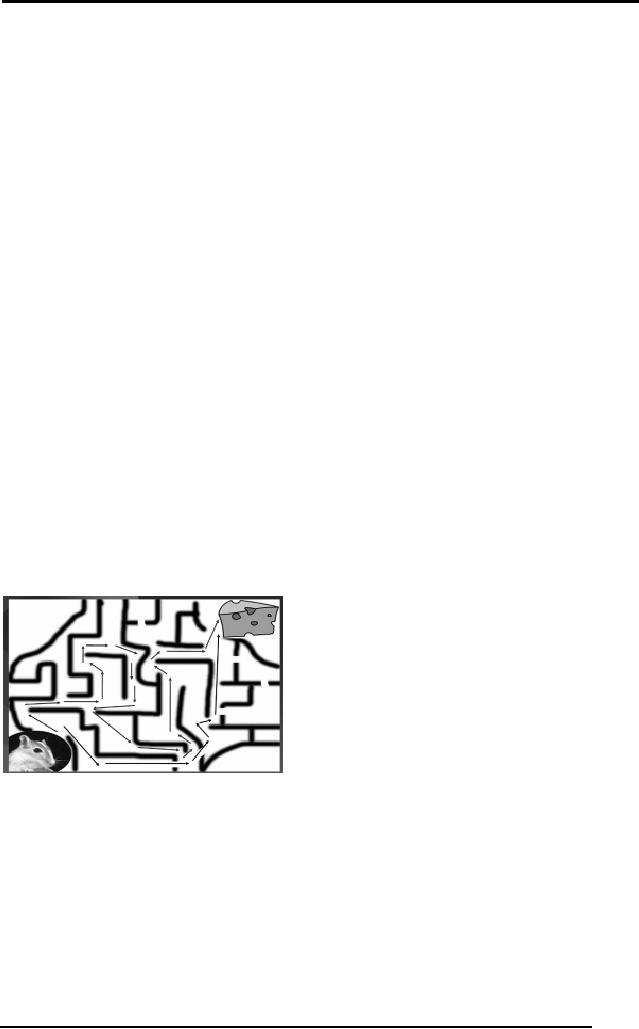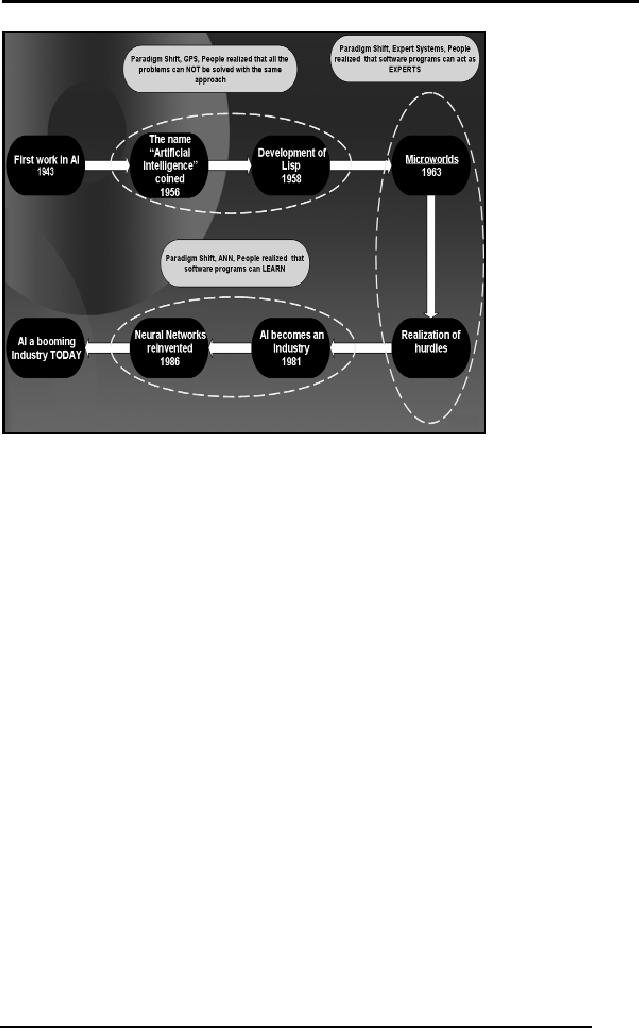 |
Detailed Table of Contents |
| Introduction >> |

Artificial
Intelligence (CS607)
Artificial
Intelligence
1
Introduction
This
booklet is organized as chapters
that elaborate on various
concepts of
Artificial
Intelligence. The field
itself is an emerging area of
computer sciences
and a lot of
work is underway in order to
mature the concepts of this
field.
In this
booklet we will however try
to envelop some important
aspects and basic
concepts
which will help the
reader to get an insight
into the type of topics
that
Artificial
Intelligence deals
with.
We have
used the name of the
field i.e. Artificial
Intelligence (commonly
referred
as AI) without any
explanation of the name
itself. Let us now look
into a simple
but
comprehensive way to define the
field.
To define AI,
let us first try to
understand that what is Intelligence?
1.1 What is
Intelligence?
If you
were asked a simple
question; how can we define
Intelligence, many
of
you would
exactly know what it is but
most of you won't exactly be
able to define
it. Is it something tangible?
We
all know that it does
exist but what actually it
is.
Some of us
will attribute intelligence to
living beings and would be of
the view that
all
living species are
intelligent. But how about
these plants and tress,
they are
living
species but are they
also intelligent? So can we
say that Intelligence is
a
trait of
some living
species? Let us try to
understand the phenomena
of
intelligence by
using a few examples.
Consider
the following image where a
mouse is trying to search a
maze in order
to find
its way from the bottom
left to the piece of cheese
in the top right corner
of
the
image.
This
problem can be considered as a
common real life problem
which we deal
with
many times in our life,
i.e. finding a path, may be to a
university, to a friends
house, to a
market, or in this case to
the piece of cheese. The
mouse tries
various
paths as shown by arrows and
can reach the cheese by
more than one
path. In
other words the mouse
can find more than one
solutions to this
problem.
The mouse
was intelligent
enough to
find a solution to the
problem at hand.
Hence
the ability of problem solving
demonstrates
intelligence.
Let us
consider another problem.
Consider the sequence of
numbers below:
1, 3, 7, 13,
21, ___
4

Artificial
Intelligence (CS607)
If you
were asked to find the
next number in the sequence
what would be your
answer?
Just to help you out in the
answer let us solve it for
you "adding the
next
even
number to the" i.e. if we add 2 to 1 we
get 3, then we add 4 to 3 we
get 7,
then we
get 6 to 7 we get 13, then
we add 8 to 13 we get 21 and finally if
we'll
add 10 to 21 we'll
get 31 as the answer. Again
answering the question
requires a
little
bit intelligence. The characteristic of
intelligence comes in when we
try to
solve
something, we check various
ways to solve it, we check
different
combinations,
and many other things to
solve different problems.
All this thinking,
this
memory manipulation capability,
this numerical processing
ability and a lot of
other
things add to ones
intelligence.
All of
you have experienced your
college life. It was very
easy for us to look at
the
timetable and go
to the respective classes to
attend them. Not even caring
that
how
that time table was
actually developed. In simple
cases developing such
a
timetable is
simple. But in cases where
we have 100s of students
studying in
different
classes, where we have only
a few rooms and limited
time to schedule
all
those classes. This gets
tougher and tougher. The
person who makes
the
timetable
has to look into all
the time schedule,
availability of the
teachers,
availability of
the rooms, and many
other things to fit all
the items correctly
within
a fixed
span of time. He has to look
into many expressions and
thoughts like "If
room A is
free AND teacher B is ready to
take the class AND the
students of the
class
are not studying any other
course at that time" THEN
"the class can be
scheduled".
This is a fairly simple one,
things get complex as we add
more and
more
parameters e.g. if we were to
consider that teacher B
might teach more
than one
course and he might just
prefer to teach in room C and
many other
things
like that. The problem gets
more and more complex. We
are pretty much
sure
than none of us had ever
realized the complexity
through which our
teachers
go through
while developing these
schedules for our classes.
However, like we
know
such time tables can be
developed. All this
information has to reside in
the
developer's
brain. His intelligence
helps him to create such a
schedule. Hence
the ability to think, plan and
schedule demonstrate
intelligence.
Consider a
doctor, he checks many
patients daily, diagnoses
their disease gives
them
medicine and prescribes them
behaviors that can help
them to get cured.
Let us
think a little and try to
understand that what
actually he does.
Though
checking a
patient and diagnosing the
disease is much more complex
but we'll try
to keep
our discussion very simple
and will intentionally miss
out stuff from
this
discussion.
A person
goes to doctor, tells him
that he is not feeling well.
The doctor asks him
a few
questions to clarify the
patient's situation. The doctor
takes a few
measurements to
check the physical status of
the person. These
measurements
might
just include the temperature
(T), Blood Pressure (BP),
Pulse Rate (PR) and
things
like that. For simplicity
let us consider that some
doctor only checks
these
measurements and
tries to come up with a
diagnosis for the disease.
He takes
these
measurements and based on his
previous knowledge he tries to
diagnose
the
disease. His previous
knowledge is based on rules
like: "If the patient
has a
high BP and
normal T and normal PR then he is
not well". "If only
the BP is
normal
then what ever the
other measurements may be
the person should be
healthy", and
many such other
rules.
5

Artificial
Intelligence (CS607)
The key thing to
notice is that by using such
rules the doctor might
classify a
person to be
healthy or ill and might as
well prescribe different
medicines to him
using
the information observed
from the measurements
according to his
previous
knowledge.
Diagnosing a disease has
many other complex
information and
observations
involved, we have just
mentioned a very toy case
here. However,
the
doctor is actually faced
with solving a problem of
diagnosis having looked
at
some
specific measurements. It is important to
consider that a doctor who
would
have a
better memory to store all
this precious knowledge,
better ability of
retrieving
the correct portion of the
knowledge for the correct
patient will be
better
able to
classify a patient. Hence,
telling us that memory and correct
and
efficient memory
and information manipulation also
counts towards ones
intelligence.
Things
are not all that
simple. People don't think
about problems in the
same
manner.
Let us give you an extremely
simple problem. Just tell us
about your
height. Are you
short, medium or tall? An
extremely easy question!
Well you
might
just think that you
are tall but your
friend who is taller than
you might say
that
NO! You are not. The
point being that some
people might have such
a
distribution in
their mind that people
having height around 4ft
are short, around
5ft
are
medium and around 6ft
are tall. Others might
have this distribution
that
people
having height around 4.5ft
are short, around 5.5ft
are medium and
around
6.5ft
are tall. Even having
the same measurements
different people can get
to
completely
different results as they
approach the problem in
different fashion.
Things
can be even more complex
when the same person,
having observed
same
measurements solves the same
problem in two different
ways and reaches
different
solutions. But we all know
that we answer such fuzzy
questions very
efficiently in
our daily lives. Our
intelligence actually helps us do
this. Hence the
ability to tackle
ambiguous and fuzzy problems demonstrates
intelligence.
Can
you recognize a person just
by looking at his/her fingerprint?
Though we all
know
that every human has a
distinct pattern of his/her
fingerprint but just
by
looking at a
fingerprint image a human
generally can't just tell
that this print
must
be of person XYZ.
On the other hand having
distinct fingerprint is really
important
information as it
serves as a unique ID for
all the humans in this
world.
Let us
just consider 5 different
people and ask a sixth one to
have a look at
different
images of their fingerprints. We
ask him to somehow learn
the patterns,
which
make the five prints
distinct in some manner.
After having seen the
images
a several
times, that sixth person
might get to find something
that is making the
prints
distinct. Things like one of
them has fever lines in
the print, the other
one
has
sharply curved lines, some
might have larger distance
between the lines in
the
print and some might have
smaller displacement between
the lines and many
such
features. The point being
that after some time,
which may be in hours or
days or may be
even months, that sixth
person will be able to look
at a new
fingerprint of
one of those five persons
and he might with some
degree of
accuracy
recognize that which one
amongst the five does it
belong. Only with 5
people
the problem was hard to
solve. His intelligence
helped him to learn
the
features
that distinguish one finger
print from the other.
Hence the ability to
learn and
recognize demonstrates
intelligence.
6

Artificial
Intelligence (CS607)
Let us
give one last thought and
then will get to why we have
discussed all this. A
lot of us
regularly watch television.
Consider that you switch
off the volume of
your TV
set. If you are watching a
VU lecture you will somehow
perceive that the
person
standing in front of you is not
singing a song, or anchoring a
musical show
or playing
some sport. So just by
observing the sequence of
images of the
person you
are able to perceive
meaningful information out of
the video. Your
intelligence
helped you to perceive and understand
what was happening on
the
TV. Hence
the ability to understand and
perceive demonstrates
intelligence.
1.2
Intelligent Machines
The discussion in
the above section has a
lot of consequences when we
this it
with a
different perspective. Let us
show you something really
interesting now
and hence
informally define the field
of Artificial Intelligence at the
same time.
What
if?
A machine
searches through a mesh and
finds a path?
A machine
solves problems like the
next number in the
sequence?
A machine
develops plans?
A machine
diagnoses and prescribes?
A machine
answers ambiguous
questions?
A machine
recognizes fingerprints?
A machine
understands?
A machine
perceives?
A machine
does MANY MORE SUCH THINGS!
A machine
behaves as HUMANS do? HUMANOID!!!
We will
have to call such a machine
Intelligent. Is this
real or natural
intelligence?
NO!
This
is Artificial
Intelligence.
1.3 Formal
Definitions for Artificial
Intelligence
In their
book "Artificial Intelligence: A
Modern Approach" Stuart
Russell and Peter
Norvig
comment on artificial intelligence in a
very comprehensive manner.
They
present
the definitions of artificial
intelligence according to eight
recent textbooks.
These
definitions can be broadly
categorized under two
themes. The ones in
the
left
column of the table below
are concerned with thought process
and
reasoning, where as
the ones in the right
column address behavior.
Systems that think
like
Systems that act
like
humans
humans
"The
exciting new effort
"The
art of creating
to make
computers think
machines
that perform
... machines
with minds,
functions
that require
in the
full and literal
intelligence
when
sense"
(Haugeland,
performed by
people"
1985)
(Kurzweil
1990)
"[The
automation of]
"The
study of how to
activities
that
we
make
computers do
associate
with human
things at
which, at the
thinking,
activities such
moment,
people are
7

Artificial
Intelligence (CS607)
as decision
making,
better"
(Rich and Knight,
problem
solving,
1991)
learning ..."
(Bellman,
1978)
"The
study of mental
"A field of
study that
faculties
through the use
seeks to
explain and
of
computational
emulate
intelligent
models"
(Charniak and
behavior in
terms of
McDermott)
computational
processes"
(Schalkoff,
1990)
"The
study
of
"The
branch of computer
computation
that make it
science
that
is
possible to
perceive
concerned
with
the
reason
and
act"
automation of
intelligent
(Winston
1992)
behavior"
(Luger and
Stubblefield,
1993)
To make
computers think like humans
we first need to devise ways
to determine
that
how humans think. This is
not that easy. For
this we need to get inside
the
actual
functioning of the human
brain. There are two
ways to do this:
Introspection:
that is trying to catch out
own thoughts as they go
by.
Psychological
Experiments: that concern
with the study of science
of
mental
life.
Once we
accomplish in developing some
sort of comprehensive theory
that how
humans
think, only then can we
come up with computer
programs that follow
the
same
rules. The interdisciplinary field of
cognitive science brings
together
computer
models from AI and
experimental techniques from
psychology to try to
construct
precise and testable theories of
the working of human
mind.
The issue of
acting like humans comes up
when AI programs have to
interact
with
people or when they have to
do something physically which
human usually
do in real
life. For instance when a
natural language processing
system makes a
dialog
with a person, or when some
intelligent software gives
out a medical
diagnosis, or
when a robotic arm sorts
out manufactured goods over
a conveyer
belt and
many other such
scenarios.
Keeping in
view all the above
motivations let us give a
fairly comprehensive
comment
that Artificial Intelligence is an
effort to create systems
that can learn,
think,
perceive, analyze and act in
the same manner as real
humans.
People
have also looked into
understanding the phenomena of
Artificial
Intelligence
from a different view point.
They call this strong
and weal AI.
Strong AI
means that machines act
intelligently and they have
real conscious
minds.
Weak AI says that machines
can be made
to
act as if they are
intelligent.
That is
Weak AI treats the brain as
a black box and just emulates
its functionality.
While
strong AI actually tries to
recreate the functions of
the inside of the brain
as
opposed to
simply emulating
behavior.
8

Artificial
Intelligence (CS607)
The concept
can be explained by an example.
Consider you have a
very
intelligent
machine that does a lot of
tasks with a lot of
intelligence. On the
other
hand you
have very trivial specie
e.g. a cat. If you throw
both of them into a
pool
of water,
the cat will try to
save her life and
would swim out of the
pool. The
"intelligent"
machine would die out in
the water without any effort
to save itself.
The mouse had
strong Intelligence, the
machine didn't. If the
machine has strong
artificial
intelligence, it would have
used its knowledge to
counter for this
totally
new
situation in its environment.
But the machine only
knew what we taught it
or
in other
wards only knew what
was programmed into it. It
never had the
inherent
capability of
intelligence which would
have helped it to deal with
this new
situation.
Most of
the researchers are of the
view that strong AI can't
actually ever be
created and
what ever we study and
understand while dealing
with the field of AI
is related to
weak AI. A few are also of
the view that we can
get to the essence of
strong AI as
well. However it is a standing
debate but the purpose
was to
introduce you
with another aspect of
thinking about the
field.
1.4
History and Evolution of Artificial
Intelligence
AI is a young
field. It has inherited its
ideas, concepts and techniques
from many
disciplines
like philosophy, mathematics,
psychology, linguistics, biology
etc.
From
over a long period of
traditions in philosophy theories of
reasoning and
learning
have emerged. From over
400 years of mathematics we
have formal
theories of
logic, probability, decision-making and
computation. From
psychology
we have
the tools and techniques to
investigate the human mind
and ways to
represent
the resulting theories.
Linguistics provides us with
the theories of
structure and
meaning of language. From
biology we have information
about the
network
structure of a human brain and
all the theories on
functionalities of
different
human organs. Finally from
computer science we have
tools and
concepts to
make AI a reality.
1.4.1 First
recognized work on AI
The first
work that is now generally
recognized as AI was done by
Warren
McCulloch and
Walter Pitts (1943). Their
work based on three
sources:
The
basic physiology and
function of neurons in the
human brain
The
prepositional logic
The
Turing's theory of
computation
The proposed an
artificial model of the
human neuron. Their model
proposed a
human
neuron to be a bi-state element
i.e. on or off and that
the state of the
neuron
depending on response to stimulation by a
sufficient number of
neighboring
neurons. They showed, for
example, that some network
of
connected
neurons could compute any
computable function, and that
all the
logical
connectives can be implemented by
simple net structures. They
also
suggested
that suitably connected
networks can also learn
but they didn't
pursue
this
idea much at that time.
Donald Hebb (1949) demonstrated a
simple updating
rile
for the modifying the
connection strengths between
neurons, such that
learning
could take place.
9

Artificial
Intelligence (CS607)
1.4.2 The name of
the field as "Artificial Intelligence"
In 1956
some of the U.S researchers
got together and organized a
two-month
workshop at
Dartmouth. There were
altogether only 10 attendees.
Allen Newell
and Herbert
Simon actually dominated the
workshop. Although all
the
researchers
had some excellent ideas and
a few even had some demo
programs
like
checkers, but Newell and
Herbert already had a reasoning
program, the
Logic
Theorist. The program came up
with proofs for logic
theorems. The
Dartmouth
workshop didn't lead to any
new breakthroughs, but it
did all the
major
people
who were working in the
field to each other. Over
the next twenty
years
these
people, their students and
colleagues at MIT, CMU, Stanford and
IBM,
dominated
the field of artificial
intelligence. The most lasting and
memorable thing
that
came out of that workshop
was an agreement to adopt
the new name for
the
field:
Artificial
Intelligence. So this
was when the term
was actually coined.
1.4.3 First
program that though humanly
In the
early years AI met drastic
success. The researchers were
highly motivated
to try
out AI techniques to solve
problems that were not
yet been solved. Many
of
them
met great successes. Newell
and Simon's early success
was followed up
with
the General Problem Solver.
Unlike Logic Theorist, this
program was
developed in
the manner that it attacked
a problem imitating the
steps that
human
take when solving a problem.
Though it catered for a
limited class of
problems
but it was found out
that it addressed those
problems in a way
very
similar to
that as humans. It was
probably the first program
that imitated human
thinking
approach.
1.4.4 Development
of Lisp
In 1958 In MIT AI
Lab, McCarthy defined the
high-level language Lisp that
became
the dominant AI programming
language in the proceeding
years. Though
McCarthy
had the required tools
with him to implement
programs in this
language
but
access to scarce and
expensive computing resources
were also a serious
problem.
Thus he and other researchers at MIT
invented t8ime sharing. Also
in
1958 he
published a paper titled Programs with
Common Sense, in which
he
mentioned
Advice
Taker a hypothetical
that can be seen as the
first complete AI
system.
Unlike the other systems at
that time, it was to cater
for the general
knowledge of
the world. For example he
showed that how some
simple rules
could
help a program generate a
plan to drive to an airport and
catch the plane.
1.4.5
Microworlds
Marvin
Minsky (1963), a researcher at MIT
supervised a number of students
who
chose
limited problems that
appeared to require intelligence to
solve. These
limited
domains became known as Microworlds.
Some
of them developed
programs
that solved calculus
problems; some developed
programs, which were
able to
accept input statements in a
very restricted subset of
English language,
and generated
answers to these statements. An
example statement and an
answer
can be:
Statement:
If Ali is 2
years younger than Umar and
Umar is 23 years old. How
old is Ali?
Answer:
Ali is 21
years old.
10

Artificial
Intelligence (CS607)
In the
same era a few researchers
also met significant
successes in building
neural
networks but neural networks
will be discusses in detail in
the section titled
"Learning" in this
book.
1.4.6 Researchers
started to realize problems
In the
beginning the AI researchers
very confidently predicted
their up coming
successes.
Herbert Simon in 1957
said:
It is not my aim to
surprise of shock you -- but the simplest way I
can
summarize is to
say that there are now in the world machines that
think,
that learn and that
create. Moreover, their ability to do these things is
going
to increase
rapidly until -- in a visible future the range of problems
they
can handle will be
coextensive with the range to which human mind
has
been
applied
In 1958 he
predicted that computers
would be chess champions,
and an
important
new mathematical theorem
would be proved by machine.
But over the
years it
was revealed that such
statements and claims were
really optimistic. A
major
problem that AI researchers
started to realize was that
though their
techniques
worked fairly well on one or
two simple examples but
most of them
turned
out to fail when tried
out on wider selection of
problems and on more
difficult
tasks.
One of
the problems was that
early programs often didn't
have much knowledge
of their
subject matter, and
succeeded by means of simple
syntactic
manipulations
e.g. Weizenbaum's ELIZA program
(1965), which could
apparently
engage in
serious conversation on any topic,
actually just borrowed
and
manipulated
the sentences typed into it
by a human. Many of the
language
translation
programs tried to translate
sentences by just a replacement of
words
without
having catered for the
context in which they were
used, hence totally
failing to
maintain the subject matter
in the actual sentence,
which was to be
translated. The
famous retranslation of "the spirit is
willing but the flesh is
weak" as "the vodka is good but the meat
is rotten"
illustrates the
difficulties
encountered.
Second
kind of difficulty was that
many problems that AI was
trying to solve were
intractable.
Most of the AI programs in
the early years tried to
attack a problem by
finding
different combinations in which a
problem can be solved and
then
combined
different combinations and
steps until the right
solution was found.
This didn't work
always.
There were many intractable
problems in which
this
approach
failed.
A third
problem arose because of the
fundamental limitations on the
basic
structures
being used to generate
intelligent behavior. For
example in 1969,
Minsky
and Papert's book Perceptrons
proved
that although perceptrons
could
be shown to
learn anything they were
capable of representing, they
could
represent
very little.
11

Artificial
Intelligence (CS607)
However, in
brief different happenings
made the researchers realize
that as they
tried
harder and more complex
problem the pace of their
success decreased so
they
now refrained from making
highly optimistic
statements.
1.4.7 AI becomes
part of Commercial Market
Even
after realizing the basic
hurdles and problems in the
way of achieving
success in
this field, the researchers
went on exploring grounds and
techniques.
The first
successful commercial expert system,
R1,
began operation at
Digital
Equipment
Corporation (McDermott, 1982). The
program basically helped
to
configure
the orders for new computer
systems. Detailed study of
what expert
systems
are will be dealt later in
this book. For now
consider expert systems as
a
programs
that somehow solves a
certain problem by using
previously stored
information
about some rules and fact of
the domain to which that
problem
belongs.
In 1981,
the Japanese announced the
"Fifth Generation" project, a
10-year plan
to build
intelligent computers running
Prolog in much the same
way that ordinary
computers
run the machine code. The
project proposed to achieve
full-scale
natural
language understanding along
with many other ambitious
goals.
However, by
this time people began to
invest in this field and
many AI projects
got
commercially funded and
accepted.
1.4.8 Neural
networks reinvented
Although
computer science had
rejected this concept of
neural networks after
Minsky and
Papert's Perceptrons
book,
but in 1980s at least four
different
groups
reinvented the back
propagation learning algorithm
which was first
found
in 1969 by
Bryson and Ho. The algorithm
was applied to many learning
problem
in computer
science and the wide
spread dissemination of the
results in the
collection
Parallel
Distributed Processing (Rumelhart and
McClelland, 1986)
caused
great excitement.
People
tried out the back
propagation neural networks as a
solution to many
learning
problems and met great
success.
12

Artificial
Intelligence (CS607)
The diagram
above summarizes the history
and evolution of AI in a
comprehensive
shape.
1.5
Applications
Artificial
finds its application is a
lot of areas not only
related to computer
sciences
but many other fields as
well. We will briefly
mention a few of the
application
areas and throughout the
content of this booklet you
will find various
applications of
the field in detail
later.
Many information
retrieval systems like
Google search engine uses
artificially
intelligent
crawlers and content based
searching techniques to efficiency
and
accuracy of
the information
retrieval.
A lot of
computer based games like
chess, 3D combat games even
many arcade
games
use intelligent software to
make the user feel as if
the machine on which
that
game is running is
intelligent.
Computer
Vision is a new area where
people are trying to develop
the sense of
visionary
perception into a machine.
Computer vision applications
help to
establish
tasks which previously
required human vision
capabilities e.g.
recognizing
human faces, understanding
images and to interpret them,
analyzing
medical
scan and innumerable amount
of other tasks.
Natural
language processing is another
area which tries to make
machines speak
and interact
with humans just like
humans themselves. This
requires a lot from
the
field of Artificial
Intelligence.
13

Artificial
Intelligence (CS607)
Expert
systems form probably the
largest industrial applications of AI.
Software
like MYCIN
and XCON/R1 has been
successfully employed in medical
and
manufacturing
industries respectively.
Robotics
again forms a branch linked
with the applications of AI
where people are
trying to
develop robots which can be
rather called as humanoids.
Organizations
have
developed robots that act as
pets, visitor guides
etc.
In short
there are vast applications
of the field and a lot of
research work is
going
on around
the globe in the
sub-branches of the field.
Like mentioned
previously,
during
the course of the booklet
you will find details of
many application of AI.
1.6
Summary
Intelligence
can be understood as a trait of
some living species
Many factors
and behaviors contribute to
intelligence
Intelligent
machines can be
created
To create
intelligent machines we first
need to understand how the
real
brain
functions
Artificial
intelligence deals with
making machines think and
act like
humans
It is difficult to
give one precise definition of
AI
History of AI is
marked by many interesting
happenings through which
the
field
gradually evolved
In the
early years people made
optimistic claims about AI
but soon they
realized
that it's not all
that smooth
AI is employed in
various different fields
like gamming, business,
law,
medicine,
engineering, robotics, computer
vision and many other
fields
This
book will guide you though
basic concepts and some core
algorithms
that
form the fundamentals of
Artificial Intelligence
AI has
enormous room for research
and posses a diverse
future
14